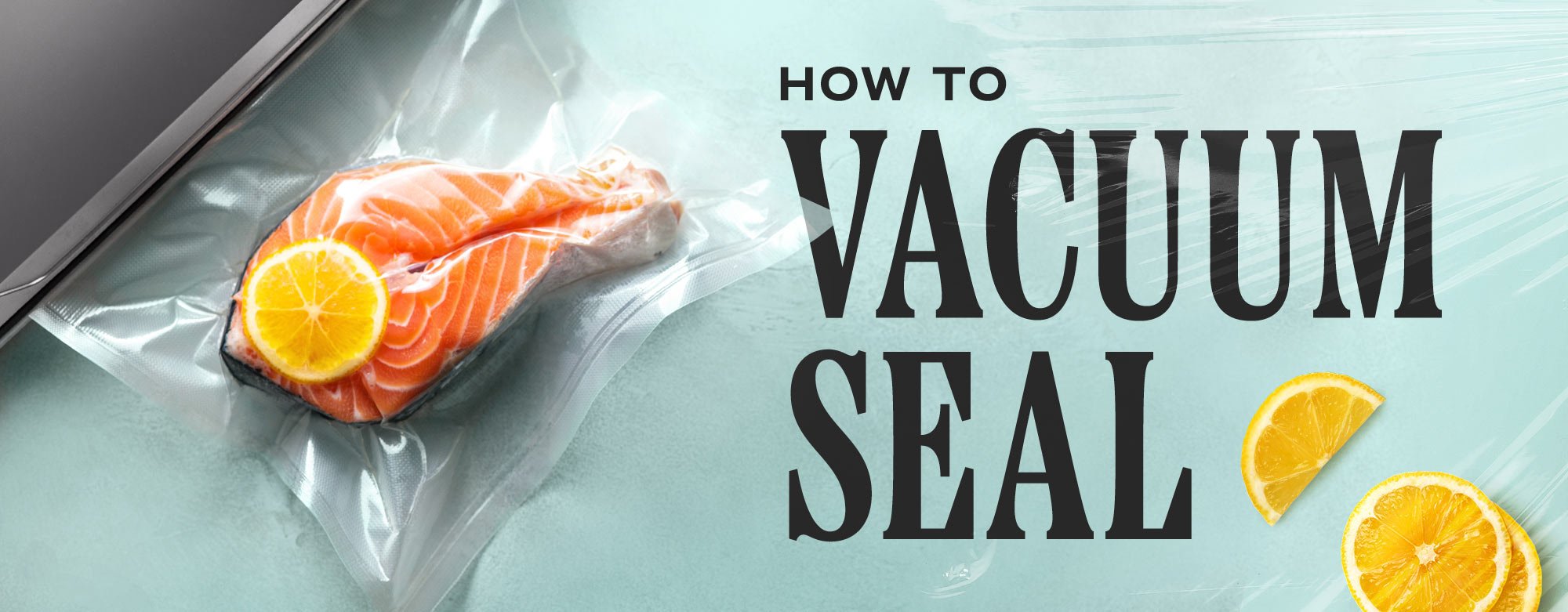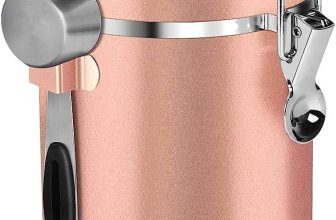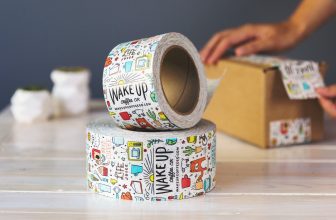Vacuum sealing extends shelf life by removing air and creating an airtight environment. By eliminating oxygen, vacuum sealing prevents oxidation and the growth of bacteria, fungi, and other microorganisms that spoil food.
This extends the freshness and quality of the sealed items, allowing them to last significantly longer than if stored in normal packaging. Vacuum sealing is commonly used for preserving a variety of food items such as meats, fruits, vegetables, and even liquids like soups and sauces.
It is a popular method for reducing food waste and ensuring that stored items remain safe to consume for extended periods of time. Additionally, vacuum sealing can also help protect against freezer burn and maintain the natural flavors and nutritional value of the sealed foods.

Credit: www.webstaurantstore.com
Understanding The Basics Of Vacuum Sealing
Vacuum sealing is an effective method to extend the shelf life of various food items. By removing the air from the packaging, vacuum sealing prevents the growth of bacteria, mold, and other microorganisms that cause food spoilage. This preservation technique works by utilizing a vacuum sealer machine, which sucks out the air and creates an airtight seal around the food.
When the oxygen is removed, the chances of oxidation and freezer burn are significantly reduced. Vacuum sealing not only helps keep food fresh for a longer period but also retains its quality and nutritional value. It is particularly beneficial for perishable items like meat, fish, vegetables, and fruits, allowing them to stay fresh and flavorful.
Whether you are storing leftovers, bulk purchases, or meal prepping, vacuum sealing is a practical and economical way to maintain the longevity of your food items.
Factors Affecting Shelf Life
Vacuum sealing is an effective method to extend the shelf life of food products. Several factors impact the overall shelf life of items. The first factor is oxygen exposure. When food comes into contact with oxygen, it can lead to oxidation and spoilage.
Vacuum sealing removes the air, preventing oxygen from causing deterioration. The second factor is moisture content. Excessive moisture in food can lead to the growth of bacteria and mold. Vacuum sealing eliminates moisture, keeping food fresh for longer periods. Lastly, temperature control is crucial.
Storing vacuum-sealed items in cool temperatures can further extend their shelf life. By eliminating oxygen exposure, controlling moisture content, and maintaining proper temperature, vacuum sealing is an effective method to prolong the freshness and quality of food products.
Benefits Of Vacuum Sealing For Extended Shelf Life
Vacuum sealing is a great way to extend the shelf life of food. By removing the air from the packaging, it helps in preserving freshness for a longer period. This method also prevents freezer burn, which can negatively impact the quality of frozen items.
Vacuum sealing delays the growth of bacteria, helping to maintain the integrity of the food. The absence of air and moisture restricts bacterial growth, reducing the risk of spoilage. Additionally, vacuum sealing can save you money by preventing food waste.
It allows you to buy in bulk and store excess food without worrying about it going bad. Overall, vacuum sealing is a simple yet effective technique that can significantly extend the shelf life of your food.
Myth 1: Vacuum Sealing Can Preserve Perishable Foods Indefinitely
Vacuum sealing is often touted as a way to extend the shelf life of perishable foods indefinitely. However, it is essential to understand the limitations of this preservation method. While vacuum sealing can certainly help prolong the freshness of food, it does not mean that the items will last forever.
Proper handling and storage are equally crucial in preventing spoilage and ensuring food safety. While vacuum sealing removes the air that promotes bacterial growth, it does not eliminate all the factors that contribute to food decay, such as temperature and moisture.
Therefore, it is still essential to follow proper food handling guidelines and store vacuum-sealed items in the appropriate conditions. By doing so, you can maximize the benefits of vacuum sealing and extend the shelf life of your perishable foods to a certain extent.
Myth 2: Vacuum Sealing Can Guarantee Safety For All Foods
Vacuum sealing is often believed to guarantee food safety, but this is not entirely true. Food safety concerns still exist when it comes to vacuum sealing. Certain high-risk foods, like raw meat or poultry, can still pose a risk even when vacuum sealed.
To ensure safety, it is important to follow best practices such as properly cleaning and sanitizing the equipment, using appropriate packaging materials, and storing the vacuum sealed food at the correct temperature. While vacuum sealing can extend the shelf life of certain foods by minimizing exposure to oxygen, it does not eliminate all potential risks.
It’s important to understand the limitations of vacuum sealing and take additional precautions to ensure food safety.
Myth 3: Vacuum Sealing Is The Only Method For Prolonging Shelf Life
Vacuum sealing is often considered the go-to method for extending the shelf life of food. However, it is important to note that there are other techniques available that can also help in prolonging shelf life. By complementing vacuum sealing with proper storage techniques, you can maximize the effectiveness of preserving your food.
One such method is refrigeration, which helps to lower the temperature and inhibit the growth of bacteria. Additionally, using airtight containers can create a barrier against moisture, oxygen, and contaminants. Another effective technique is freezing, which can significantly extend the shelf life of many foods.
By following these alternative methods in conjunction with vacuum sealing, you can ensure that your food stays fresher for longer periods, reducing waste and saving money.
Preparing Foods For Vacuum Sealing
Vacuum sealing is a powerful method for extending the shelf life of various foods. Before you start vacuum sealing, it’s crucial to properly prepare your foods. Different types of foods require different handling techniques to achieve optimal results. For meats and seafood, it’s essential to remove excess moisture and wrap them tightly before vacuum sealing.
For fruits and vegetables, blanching and freezing them beforehand helps maintain their quality. When it comes to liquids, like soups and sauces, ensure they are completely cooled before vacuum sealing. Avoid vacuum sealing soft and powdery foods, as they can get crushed.
Additionally, label and date all vacuum-sealed packages for easy identification. By following these tips and avoiding common mistakes, you can maximize the benefits of vacuum sealing and significantly extend the shelf life of your favorite foods.
Storing Vacuum Sealed Foods
Vacuum sealing is an effective way to extend the shelf life of food items. Storing vacuum-sealed foods properly is key to maintaining freshness and preventing spoilage. When choosing storage containers for vacuum-sealed foods, it is important to select ones that are specifically designed for this purpose.
These containers should be airtight and made of durable material to ensure the vacuum seal remains intact. To further optimize organization, proper labeling should be implemented. Clearly identifying the contents and date of vacuum sealing can assist with easy retrieval and avoid confusion.
By following these steps, you can maximize the shelf life of your vacuum-sealed foods, reducing waste and saving money in the long run.
Maximizing Shelf Life With Vacuum Sealing
Vacuum sealing is a highly effective method to extend the shelf life of various foods. By removing air and sealing items in airtight bags or containers, vacuum sealing prevents the growth of bacteria, mold, and yeast, which can cause spoilage.
This technique is particularly beneficial for perishable foods like meats, poultry, and fish, as it significantly slows down the degradation process. Different types of food have recommended shelf life extensions when vacuum sealed. For example, storing beef can be extended up to three to five times longer, and cheese can last three to four times longer.
Rotation and inventory management are crucial when using vacuum sealing, as it allows for proper usage of older items and reduces waste. By employing this method, individuals can maximize the shelf life of their food, reducing the need for frequent grocery shopping and saving money in the long run.
Environmental Impact Of Vacuum Sealing
Vacuum sealing is a popular method for extending the shelf life of food products. However, it is crucial to consider the environmental impact of this practice. One major concern is the excessive plastic waste generated by vacuum sealing. The use of plastic bags and packaging materials can contribute to sustainability issues, as they often end up in landfills or pollute our oceans.
To address these concerns, eco-friendly alternatives to traditional vacuum sealing methods should be explored. Biodegradable packaging, reusable containers, and sustainable materials can help mitigate the negative environmental consequences associated with vacuum sealing. By embracing these eco-friendly alternatives, we can preserve our planet’s resources while still benefiting from the extended shelf life offered by vacuum sealing.
Let’s make sustainable choices and protect our environment for future generations.
Cost Analysis And Return On Investment
Emptying your pantry into a vacuum-sealed bag may just be the secret to prolonging shelf life. But before you embark on a vacuum sealing spree, it’s crucial to consider the cost-effectiveness. By analyzing the benefits against the expenses, you can determine whether vacuum sealing is truly worth the investment.
The initial purchase of a vacuum sealer and bags should be factored in, as well as ongoing costs such as electricity. However, the potential savings derived from minimizing food waste and spoilage can outweigh the expenses. Vacuum sealing helps to preserve the quality and freshness of food, ultimately reducing the need for frequent grocery shopping.
So, when assessing the overall cost of vacuum sealing, it’s essential to weigh the advantages it brings in extending shelf life against the initial and ongoing investments.
Frequently Asked Questions Of Does Vacuum Sealing Extend Shelf Life
Does Vacuum Sealing Really Extend The Shelf Life Of Food?
Yes, vacuum sealing food can significantly extend its shelf life by removing the air, preventing the growth of bacteria, molds, and other microorganisms that cause spoilage. It also helps to retain the nutrients, flavors, and texture of the food for longer periods.
Conclusion
Vacuum sealing is an effective method to prolong the shelf life of food items. By removing the air and creating a tight seal, it prevents the growth of bacteria, mold, and other microorganisms that cause spoilage. This preservation technique not only extends the freshness of the food but also helps retain its nutritional value and flavor.
Vacuum sealing is particularly useful for storing perishable items like meats, fruits, and vegetables. It also prevents freezer burn and keeps food safe from contaminants. Whether you are a home cook or a food business owner, investing in a quality vacuum sealer can significantly reduce food waste and save you money in the long run.
So, next time you’re at the grocery store, consider vacuum sealing your purchases to enjoy their optimal quality for a longer period.





